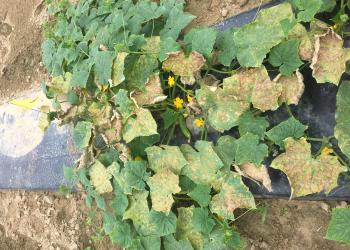Improving management of cucurbit diseases, especially cucurbit downy mildew (CDM), has been consistently identified by growers and processors in MA as a major research priority in the past ten years. In 2004, new strains of CDM arrived which had overcome resistance that was then standard in all cucumber varieties and adequately controlled the disease. Since that time, growers have struggled to produce late-season cucurbit crops, and have experienced yield losses to fall-harvested crops such as winter squash, as ripening and curing of fruit is now routinely cut short due to late-season disease. Using resistant varieties reduces growers’ reliance on fungicides, which can be very costly and time-consuming to apply with the regularity needed to adequately control disease. Furthermore, new evidence suggests that chlorothalonil, the active ingredient in the fungicide Bravo, has negative effects on honeybees which pollinate all cucurbit crops. The majority of conventional cucurbit growers rely on chlorothalonil as the backbone of preventative fungicide programs to control both powdery mildew and CDM. It has broad-spectrum activity, low risk for fungicide resistance development, and leads to significant increases in marketable yield and quality. Between the increase in demand for organically-produced cucurbit crops and the increasing concern for bee health, it is clear that finding effective new disease management tools is necessary to prevent losses and meet demand for cucurbits in MA.
Objectives
Our goal was to increase yield and quality of cucurbits by providing growers with new tools to maintain their crops in the face of increasing disease pressure, while protecting the environment and honeybees. Our objectives were to evaluate new resistant cultivars, and to evaluate the impact of combining use of host-resistance with use of alternative fungicides that pose reduced-risks to the environment and honeybees, and which can be used in organic cropping systems. A third objective was to determine the impacts of disease on yield and sales of cucurbit crops in MA, and demonstrate cost-effectiveness of controlling disease using integrated management programs.
Outcomes
Towards our goals of increasing sales, quality, and profitability of fall cucumbers, two research trials were undertaken and each repeated once. In our evaluations of new cucumber varieties, we identified two excellent new varieties with very strong CDM resistance and marketable yields, Bristol and NY264. NY264 grew latest into the fall in both years, extending the growing season by 3 to 4 weeks with no fungicide sprays. Four other varieties performed significantly better than the susceptible control but significantly worse than Bristol and NY264, including SV4719CS, DMR401, Diamondback, and Python. These varieties are now all available commercially and growers have started planting them for their fall successions, based on our educational outreach at field days, grower meetings, and subsequent word of mouth.
In our second experiment, investigating the cost-efficiency of spraying conventional or organic fungicides and/or planting resistant varieties, we learned that spraying conventional fungicides did significantly reduce disease severity but did not always improve yield. When disease pressure was very high and the variety was very susceptible, the conventional fungicide program did significantly improve disease control and marketable yield. Spraying organic fungicides did not significantly increase disease control or yield. Planting a resistant instead of susceptible variety did significantly improve marketable yield in both years.
We conducted interviews with growers at different production scales and systems to come up with baseline figures for historical disease pressure, cucumber production practices, and cucumber pricing. When the cost of materials, time, and labor to spray, and price at market are factored in, planting the resistant variety conferred a huge increase in profit in both years. The highest profits were achieved by spraying organic fungicides on the resistant variety, in part because of the increased price per pound for organic versus conventional cucumbers ($2.50/pound versus $2.00 per pound). In the spray trial, we were able to increase harvest period by 18 days in 2016 and by 48 days in 2017.
Our findings have been shared directly with 570 growers through presentations and field day demonstrations and indirectly with additional growers, extension personnel, and home gardeners through our newsletter, which reaches 2,500, and publication of technical reports and a forthcoming academic paper. Growers attending field days reported 29-36% increases in knowledge about CDM biology and management and 78-95% were likely to implement these strategies on their farms.
The project did not benefit any non-specialty crops and there were no project partners involved.
This publication was supported by the Specialty Crop Block Grant Program at the U.S. Department of Agriculture. Its contents are solely the responsibility of the authors and do not necessarily represent the official views of the USDA.
